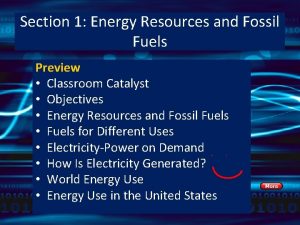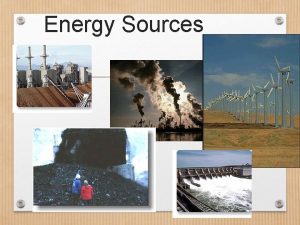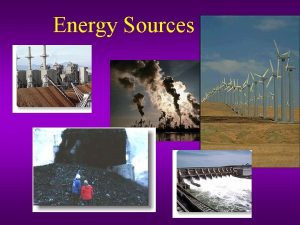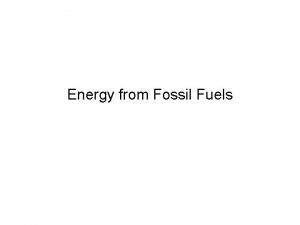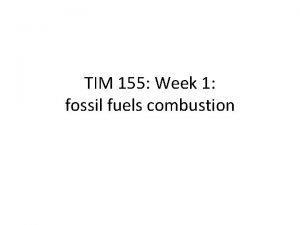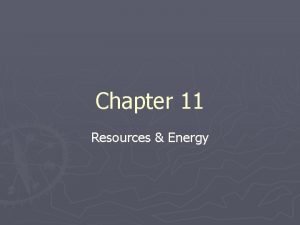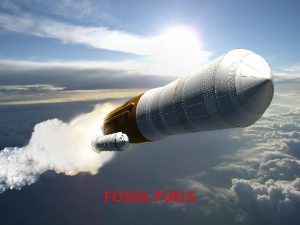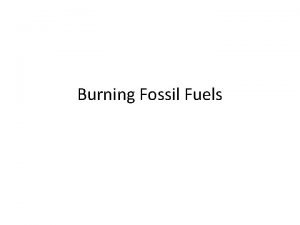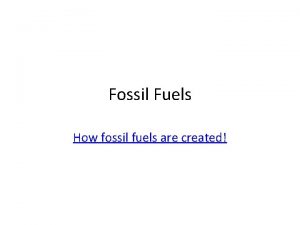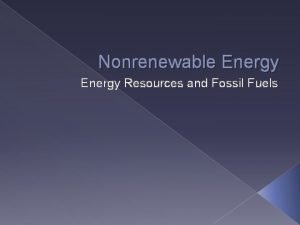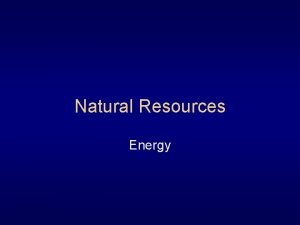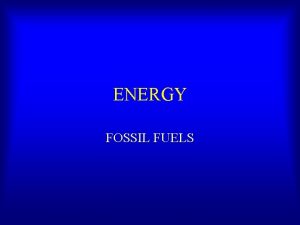Chapter 11 Resources Energy 11 2 Fossil Fuels











- Slides: 11

Chapter 11 Resources & Energy

11. 2 Fossil Fuels EQ: How are coal deposits formed?

Fossil Fuels nonrenewable resource a resource that forms at a rate that is much slower than the rate at which it is consumed fossil fuel a nonrenewable energy resource that formed from the remains of organisms that lived long ago; examples include oil, coal, and natural gas ► Much of the energy humans use every day comes from the burning of the hydrocarbons that make up fossil fuels.

Formation of Coal ► Coal is the most commonly burned fossil fuel, formed during a complex process called carbonization. ► Carbonization occurs when partially decomposed plant materials is buried in swamp mud and becomes peat. ► As bacteria consume some of the peat and release the gases methane, CH 4, and carbon dioxide, CO 2, the contents of peat gradually change until mainly carbon remains. ► Peat remains if conditions are not optimal for carbonization. Peat may be burned as fuel.

Types of Coal Deposits ► The partial decomposition of plant remains forms a brownish-black material called peat. ► Peat is buried by other sediment. As heat and pressure increase peat becomes lignite. Lignite is also called brown coal. ► Increased temperature and pressure compacts the lignite and forms bituminous coal. Bituminous coal is made of 80% carbon. ► Anthracite, the hardest form of coal, is produced when bituminous coal is under high temperatures and pressures. Anthracite coal is made of 90% carbon.

Types of Coal

Formation of Petroleum & Natural Gas ► Petroleum and natural gas are mixtures of hydrocarbons. ► These fossil fuels formed when heat and pressure caused chemical changes to the remains of microorganisms and plants.

Petroleum & Natural Gas Deposits ► Petroleum and natural gas are very important sources of energy for transportation, farming, and many other industries. ► They are mined from permeable sedimentary rocks. accumulates beneath cap rock and fill the space to form an oil reservoir. Natural gas rises above petroleum, because it is less dense than both oil and water. ► Petroleum

Oil Traps The diagram below shows how oil becomes trapped under cap rock. (see page 200. )

Oil Traps ► When a well is drilled into an oil reservoir, the petroleum and natural gas often flow to the surface. ► After the pressure of the overlying rock is removed, fluids rise up and out through the well.

Fossil Fuel Supplies ► Fossil fuels are one of the main sources of energy, but are nonrenewable resources. ► Crude oil, or unrefined petroleum, is also used in the production of plastics, synthetic fabrics and rubber, medicines, waxes, chemical fertilizers, detergents, shampoos, and many other products. ► Coal is the most abundant fossil fuel in the world. Two-thirds of the known deposits of coal occur in the United States, Russia, and China. ► Oil shale is a relatively abundant material that contains petroleum. But the cost of mining oil from shale is far greater than the present cost of recovering oil from other sedimentary rocks.
